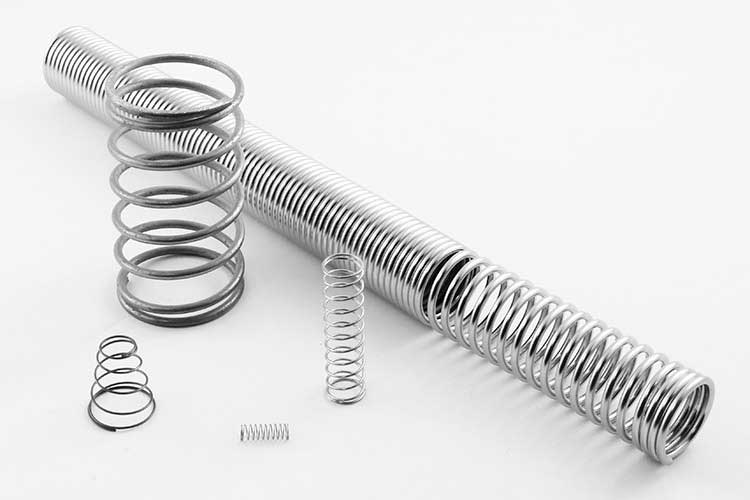Introduction
Compression springs are everywhere! You might not always see them, but they're quietly working hard in countless objects we use every day. These nifty mechanical devices store energy when compressed and release it upon expansion, making them essential for a vast range of applications. From simple ballpoint pens to intricate car suspension systems, compression springs play a vital role in modern engineering. In this article, we'll dive into the fascinating world of compression springs, exploring their design principles, analytical methods, and diverse applications.

Design Considerations for Compression Springs
Designing a compression spring isn't simply about choosing a random coil and hoping for the best. It's a meticulous process involving a delicate balance of various factors, each contributing to the spring's overall performance and longevity. Let's break down some key considerations:
Material Selection: Choosing the right material is paramount. Factors such as strength, elasticity, and resistance to fatigue and corrosion play crucial roles. Common materials include stainless steel, music wire, and various alloys, each with unique characteristics suited for specific applications.
Wire Diameter: The wire's thickness directly impacts the spring's strength and stiffness. A thicker wire results in a stronger spring capable of handling heavier loads but might compromise flexibility. A thinner wire increases flexibility but reduces load-bearing capacity.
Coil Diameter: This refers to the overall size of the spring. A larger coil diameter generally yields a spring with lower stiffness, allowing for greater deflection under load. Conversely, a smaller coil diameter leads to higher stiffness and less deflection.
Number of Active Coils: The number of coils actively participating in spring compression directly affects the spring rate, defining how much force is needed to compress the spring by a specific distance. More active coils typically mean a lower spring rate, while fewer coils lead to a higher spring rate.
Free Length: This is the spring's length in its relaxed, uncompressed state. It determines the overall travel distance the spring can accommodate. Choosing an appropriate free length is vital to ensure the spring operates within its intended range and doesn't bottom out or overextend.
Analyzing Compression Spring Behavior
Understanding how a compression spring behaves under different conditions is crucial for predicting its performance and ensuring it meets design requirements. Thankfully, we have well-established analytical methods to guide us:
Hooke's Law: This fundamental law of physics forms the bedrock of spring analysis. It states that the force exerted by a spring is directly proportional to its displacement from its equilibrium position. This relationship is neatly captured in the equation F = -kx, where F represents the spring force, k is the spring constant (a measure of stiffness), and x denotes the displacement.
Stress and Strain: These concepts are essential for assessing the spring's structural integrity. Stress refers to the internal forces experienced by the spring material when subjected to an external load. Strain, on the other hand, measures the material's deformation under stress. Analyzing stress and strain helps determine if the spring can withstand the intended loads without exceeding its elastic limit or suffering permanent deformation.
Fatigue Analysis: Springs often operate in cyclical loading conditions, repeatedly compressing and expanding. This can lead to fatigue, a gradual weakening of the material over time, eventually causing failure. Fatigue analysis techniques help estimate a spring's lifespan under specific loading conditions and inform design choices to mitigate fatigue risks.
A World of Applications
Compression springs are ubiquitous, quietly contributing to the functionality of countless devices across a vast spectrum of industries. Let's explore some prominent examples:
Automotive: From suspension systems to valve springs in engines, compression springs play a crucial role in ensuring smooth rides and efficient engine operation.
Aerospace: Compression springs are essential in landing gear systems, providing cushioning and shock absorption during takeoff and landing.
Medical Devices: They're found in various medical instruments, from surgical tools to drug delivery systems, where precise force control and reliable operation are critical.
Consumer Products: From retractable pens to spring-loaded clothespins, compression springs make everyday objects more convenient and user-friendly.
Industrial Machinery: Countless industrial applications rely on compression springs, including presses, conveyors, and manufacturing equipment, where they provide clamping force, control movement, and absorb shock.
Conclusion
Compression springs, despite their deceptively simple appearance, represent marvels of engineering ingenuity. Their ability to store and release mechanical energy fuels a vast array of applications, making them indispensable components in countless industries. Understanding the design principles, analytical techniques, and diverse applications of compression springs empowers engineers to harness their potential and create innovative solutions that shape our world.


